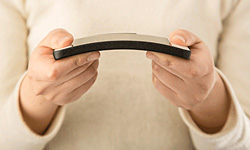Shape-Shifting Mobile Devices November 2015
Want more free featured content?
Subscribe to Insights in Brief

Today's mobile devices communicate with users via sight, sound, and vibration. Interaction researchers in laboratories in the United Kingdom, Europe, and Asia are working on expanding the capabilities of mobile devices by making it possible for them to change their shapes.
Several groups are working on prototypes featuring shape-changing metals and screens. University of Bristol researchers working on Morphees—mobile devices that change their shape depending on function—have built prototypes using shape-memory-alloy wires to manipulate a wooden model or deform a polymer substrate and also using electroactive polymers that distort when charged. Researchers at Queen's University in Canada have combined a thin, flexible electrophoretic display with shape-memory wires to create MorePhone, a bendable phone. FlexSense, developed by Christian Rendl at the University of Applied Sciences Upper Austria and Microsoft Research, is a flexible, transparent, thin-film surface that deforms when piezoelectric sensors printed onto it deform. Others are experimenting with more biomorphic designs. Young-Woo Park and colleagues at KAIST have prototyped several shape-changing devices, including Bendi, a smartphone-size device with two flexible ends that can bend, expand, or tilt, and Wrigglo, a smartphone peripheral featuring antennae that can extend or shrink, bend, and move, creating an expressive effect akin to that of a cat's ears. These antennae respond to commands from a paired device and are add a physical dimension to voice and text communication.
Implications
Bendable displays and devices can offer a number of novel functionalities. A bendable smartphone can curve or fold to protect a user's privacy when reading sensitive messages or typing passwords or curl at the edges to provide a better grip during game play. Physical changes can unobtrusively alert users to new messages. Lancaster University researchers testing protrusion, expansion, and corner bending to alert users to new messages found that users detected shape changes more quickly than they did traditional vibrotactile sensations and could easily distinguish changes in the frequency or degree of shape changing. Finally, physical gestures can serve as another communication channel between people. In field experiments, couples using Bendi quickly assigned emotional meanings to its various motions.
Impacts/Disruptions
Researchers estimate that bendable devices could be commercially available within five years, if materials can become sturdy enough to survive everyday use and durable enough to perform for years and if batteries can become powerful enough to handle the demands of shape-memory metals or electroactive polymers. But in addition to enriching communication between users, shape changing could allow the next generation of mobile objects to express emotions. HCI researcher Fabian Hemmert's studies show that users interacting with mobile devices assign consistent emotional values to actions by devices: They take leaning forward, for example, to indicate interest; moving back signals reluctance or fear. The idea may seem far-fetched at first, but with the rise of conversational interfaces on (or accessed through) smartphones and the growing popularity of drones and robots, giving mobile devices the ability to move and express emotions may not strike future users as unusual.